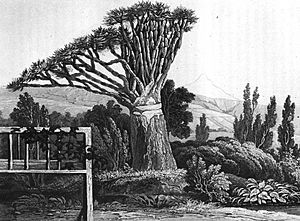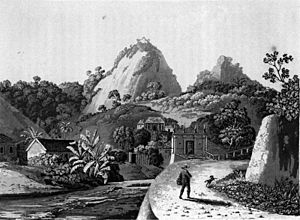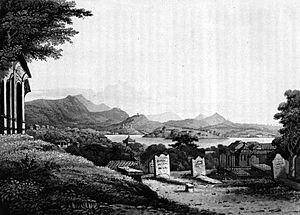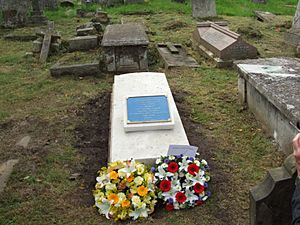Maria Graham facts for kids
Quick facts for kids
Maria Graham
|
|
|---|---|
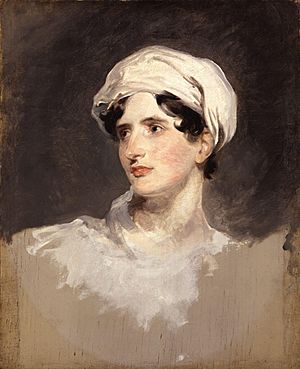
Maria, Lady Callcott
by Sir Thomas Lawrence |
|
| Born |
Maria Dundas
19 July 1785 |
| Died | 21 November 1842 (aged 57) |
| Nationality | British |
| Other names | Maria, Lady Callcott |
| Occupation | Author |
| Years active | 1811–1842 |
| Spouse(s) | Thomas Graham Augustus Wall Callcott |
| Parent(s) | George Dundas Ann Thompson |
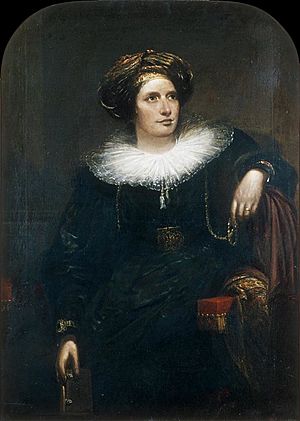
Maria Graham (born Maria Dundas; 19 July 1785 – 21 November 1842), later known as Maria, Lady Callcott, was a British writer. She wrote many travel books and children's books. She was also a very talented illustrator, drawing pictures for her books. Maria was famous for her ideas about how earthquakes can change the land. At first, some people didn't believe her, but she was proven right!
Contents
Maria's Early Life and Adventures
Maria Dundas was born in England, near a town called Cockermouth. She didn't see her father much when she was young. He was George Dundas, a naval officer, which meant he worked on ships for the navy.
Her father was a captain and commanded a ship called HMS Juno. Later, he commanded HMS Elephant. This ship was famous because it had been Nelson's main ship during a big sea battle in 1801. Her father sailed this ship to Jamaica to patrol the waters there.
In 1808, her father stopped fighting at sea. He got a job in Bombay, India, working for the East India Company. This company was a powerful British trading company. Maria, who was 23, went with him to India.
During the long trip, Maria met and fell in love with a young Scottish naval officer named Thomas Graham. They got married in India in 1809.
In 1811, Maria and Thomas returned to England. Maria published her first book, Journal of a Residence in India. Soon after, she wrote Letters on India.
Becoming a Widow and Exploring Chile
Like many wives of naval officers, Maria spent years waiting for her husband to return from sea. She lived in London most of this time. But Maria was different from other wives. She worked as a translator and edited books.
In 1819, she lived in Italy for a while. This trip led to her book, Three Months Passed in the Mountains East of Rome. Maria loved art, so she also wrote a book about a French painter named Nicolas Poussin in 1820.
In 1821, Maria was invited to travel with her husband on his ship, HMS Doris. They were sailing to Chile to protect British business interests there. But in April 1822, a sad event happened. Her husband died of a fever shortly after the ship sailed around Cape Horn.
So, HMS Doris arrived in Valparaíso without its captain, and with a very sad Maria. Other naval officers offered to help her, but Maria wanted to be independent. She rented a small house and lived among the Chilean people for a year.
In 1822, Maria experienced a huge earthquake in Chile. She wrote down everything she saw in great detail. She noted that after the earthquake, the land along the shore was "about four feet higher out of the water than before." This idea, that the land could be lifted up by an earthquake, was new and surprising to many. Some people didn't believe her, but her observations were later proven to be correct.
Teaching a Princess in Brazil

In 1823, Maria started her journey back to Britain. On the way, she stopped in Brazil. There, she met the new Brazilian emperor and his family. Brazil had just become independent from Portugal.
Maria was asked to become the teacher for the young Princess Maria da Gloria. So, when she reached London, she gave her new book manuscripts to her publisher. These books were Journal of a Residence in Chile and Journal of a Voyage to Brazil. She then gathered school supplies and returned to Brazil in 1824.
Maria stayed in the royal palace only for a few months. Some people at the palace were suspicious of her and thought she wanted to make the princess too "English." So, she was asked to leave.
Even after leaving the palace, Maria became good friends with the empress, Maria Leopoldina of Austria. They both loved natural sciences. Maria had trouble getting a ship back home and had to stay in Brazil until 1825.
In March 1826, the King of Portugal died. His son Pedro became king, but he chose to remain Emperor of Brazil. So, he gave the Portuguese throne to his six-year-old daughter, Princess Maria da Gloria.
Writing About a Famous Ship's Journey
After Maria returned from Brazil in 1825, her publisher, John Murray, asked her to write a book. It was about a famous trip made by the ship HMS Blonde to the Sandwich Islands (now called Hawaii).
The King and Queen of Hawaii had visited London in 1824. Sadly, they both died of the measles because they had no protection against the disease. The British government sent HMS Blonde to take their bodies back to the Hawaiian Kingdom.
Maria's book, Voyage Of The H.M.S. Blonde To The Sandwich Islands, told the story of the royal couple's visit and the ship's journey. It also included a history of the Hawaiian Islands. Her book is still an important source of information about this voyage and the funeral ceremony for the Hawaiian rulers. Maria wrote it using official papers and journals from the ship.
A Second Marriage and New Home
When Maria arrived in London, she found a place to live in Kensington Gravel Pits. This area was a popular spot for artists. Many famous painters lived there, like Augustus Wall Callcott, John Linnell, David Wilkie, and J. M. W. Turner. Musicians also lived nearby.
Maria's home quickly became a meeting place for smart people in London. Her publisher, John Murray, and the poet Thomas Campbell often visited. Maria was a skilled illustrator and knew a lot about painting. So, she quickly became part of the artists' group too.
Maria and Augustus Callcott got married on his birthday, 20 February 1827. They went on a year-long trip to Italy, Germany, and Austria. They studied art and buildings and met many important art experts.
Facing Disability and Writing for Children
In 1831, Maria Callcott became physically disabled after a blood vessel burst. She could no longer travel, but she continued to welcome friends and write.
In 1828, she had published A Short History of Spain. After her illness, she wrote two more books. One was about a famous chapel in Italy. The other was her most famous book for children, Little Arthur’s History of England. This book has been printed many times since then. In 1836, she also wrote a French version called Histoire de France du petit Louis.
A Debate About Earthquakes
In the mid-1830s, Maria's description of the 1822 earthquake in Chile caused a big discussion among geologists (scientists who study the Earth). She was in the middle of a disagreement between two groups of scientists who had different ideas about earthquakes and how they form mountains.
Maria had written about the earthquake in her Journal of a Residence in Chile. She also wrote a detailed letter about it to Henry Warburton, one of the founders of the Geological Society of London. Since her account was one of the first detailed eyewitness reports by a "learned person," it was published in a science journal in 1823.
One of Maria's observations was that large areas of land had risen out of the sea. In 1830, this observation was used by the geologist Charles Lyell in his important book, The Principles of Geology. Lyell used Maria's findings to support his idea that mountains were formed by volcanoes and earthquakes.
Four years later, the president of the Geological Society, George Bellas Greenough, decided to challenge Lyell's ideas. Instead of attacking Lyell directly, he publicly made fun of Maria Callcott's observations.
But Maria Callcott was not someone who would let herself be ridiculed! Her husband and nephew offered to challenge Greenough to a duel (a fight to defend honor). But Maria told them, "Be quiet, both of you, I am quite capable of fighting my own battles, and intend to do it." She then wrote a very strong reply to Greenough.
Soon after, Charles Darwin supported Maria. He had observed the same land rising during Chile's earthquake in 1835 while he was on the ship Beagle. This proved Maria's observations were correct.
In 1837, Augustus Callcott was made a knight, and Maria became known as Lady Callcott. Her health began to get worse, and she died in 1842 at age 57. She kept writing until the end. Her last book was A Scripture Herbal, which was about plants and trees mentioned in the Bible.
Honored in Chile
In 2008, the Chilean government honored Maria Callcott. They paid to restore her grave and her husband's grave in Kensal Green Cemetery in London. They did this because Maria was one of the first people to write about the new nation of Chile in English.
A special plaque was put on the grave on 4 September 2008. The Chilean ambassador to the United Kingdom, Rafael Moreno, unveiled it. The plaque calls Maria Callcott "a friend of the nation of Chile."
Maria's Books
Here are some of the books Maria wrote:
- As Maria Graham:
- Journal of a residence in India (1812)
- Letters on India, with etchings and a map (1814)
- Memoir of the life of Nicolas Poussin (1820)
- Journal of a residence in Chile during the year 1822; and a voyage from Chile to Brazil in 1823 (1824)
- Voyage of the H.M.S. Blonde to the Sandwich Islands, in the years 1824-1825 (1826)
- As Maria Callcott or Lady Callcott:
- Histoire de France du petit Louis (1836)
- A scripture herbal (1842)
See also
 In Spanish: Maria Callcott para niños
In Spanish: Maria Callcott para niños


